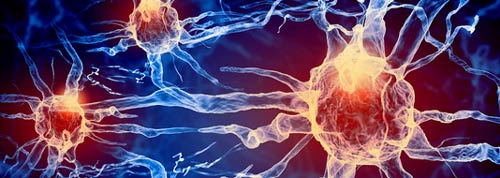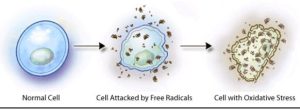Antioxidants are CRUCIAL to our health. They are even more important today than ever before in human history because our bodies are subjected to an astronomical amount of “radical-generating exposures” every day. If you sit in front of a computer, carry a cell phone, use a microwave, or drive a car, then your body is under assault. It HAS to have the defenses to combat these insults.
Free radicals are waste by-products created when the body turns food into energy. When they are not properly and fully evacuated, free radicals cause harmful chemical reactions that can damage cells in the body. Over time, they can also damage organs and tissues.
Free radicals, and oxidative stress, are at the heart of most chronic and deadly pathologies, such as cancer, heart disease, diabetes, and neurodegenerative diseases such as Alzheimer’s. Therefore we need powerful antioxidants to minimize the damage.
However, there is a catch. What constitutes a “powerful” antioxidant may not be what you have been led to believe. One of the biggest myths touted by the nutrition industry is that all antioxidants are created equal and nothing could be further from the truth. Read on to discover what one compound every person should be taking, HOW they should be taking it, and why.
Take the Quiz, but HINT: all the answers are the same!
Do you know which antioxidant:
- DOES NOT BECOME A FREE RADICAL ITSELF after it squelches a free radical and is known as the “SUICIDAL OR TERMINAL ANTIOXIDANT”?
- Squelches the most free radicals at a rate of 10:1 versus 1:1 of traditional antioxidants? (Meaning: For every one molecule of this compound it squelches 10 free radicals vs. squelching only 1 free radical)
- Can cross all cellular and subcellular structures, including the mitochondria, the powerhouse of cells?
- Protects from mitochondrial damage? Do you know that about 80% of all free radicals in our body are generated in the mitochondria of cells as a result of the necessary formation of energy (ATP)?
- Actually INCREASES GLUTATHIONE production, our body’s own powerful antioxidant?
- Squelches the most harmful free radicals known as “reactive NITROGEN species”, or RNS?
- Is both cytoTOXIC to cancer cells yet cytoPROTECTANT to normal cells? Has been shown to be synergistic with many current chemotherapies and radiation treatments in most cancers?
- Has anti-viral and anti-bacterial properties?
- Can protect your skin from harmful UV-rays and its potential for damage?
- Research states may help prevent Alzheimer’s and other neurodegenerative diseases?
- Is known as the “anti-aging” compound, in part due its protective effects against oxidative damage to lipids, proteins and most importantly DNA?
- Is deficient in more than 65% of Autistic Patients?
- Research recommends for almost all human pathologies and has no toxicity or known contraindications?
And the answer is: MELATONIN.
OKAY, so I can go to my favorite vitamin website or corner store and buy a bottle of this powerful compound and rest easy tonight, right?
ABSOLUTELY NOT. Our goal is two-fold. First, to make you aware of the power of melatonin, but second, to REINFORCE that melatonin, much like many beneficial antioxidants, is NOT ORALLY BIOAVAILABLE and you cannot achieve the required dosages to exert these profound effects when you take it in a pill or capsule.
Orally-delivered Melatonin has been shown to be an inefficient means of delivering therapeutic dosages of Melatonin. Research has shown the oral bioavailability of melatonin is 15% or less. This physical property has deemed melatonin to be classified by pharmacologists as a low permeability compound (i.e. poor absorption).
The melatonin that is absorbed must undergo further metabolism in the liver. The liver does not release melatonin efficiently and much of this melatonin is essentially “trapped” in the liver.
The Zetpil™ Melatonin deep-penetrating cream and suppository are far more powerful than any oral product currently on the market. This is because melatonin is poorly absorbed and undergoes large first pass metabolism. As an example, if you were to take 3 mgs of oral MELATONIN, that would equal 450mcgs (micrograms) in your bloodstream for less than 30 minutes, 225 mcgs at the 30 minute mark and out of the bloodstream in less than 1 hour. To maintain even this very low blood level you would have to take the product every hour.
As a sustained release delivery system, the suppositories achieve a dosage level 35 times higher for 12 consecutive hours, and no pills every hour.
A cost comparison of taking pills every hour versus suppository once would be something like this:
The average cost for 180 capsules or tablets of 3mg melatonin ranges from $12.00-20.00. Therefore, for the sake of an argument, we will user the lower cost of $12.00 per bottle. In order for the oral dosage to achieve the equivalent of 16 mgs dosage absorbed into the bloodstream (roughly 80-85% absorption with suppository and very little going to the liver), one would need to take 35 capsules every hour and would need to do so for 11 consecutive hours. This means one would need to take approximately 2 bottles per night ($24.00) every night with a cost totaling $720 per month. AND YOU STILL WOULD NEED TO GET UP EVERY HOUR FOR 11 CONSECUTIVE HOURS THROUGHOUT THE NIGHT OR TAKE A HANDFUL OF PILLS EVERY HOUR THROUGHT THE DAY (IF YOU CAN STAY AWAKE). WITH THE SUPPOSITORY or CREAM, YOU ARE PAYING APPROXIMATELY $4.00 A NIGHT, for a total monthly cost of $120-199, depending on preferred dosage.
Most importantly, the research has demonstrated unequivocally that melatonin is completely non-toxic, has very few and mild side effects and is completely safe to take with most, if not all, medications. No toxic dosage has ever been achieved, even at very high dosages.
This combination of effectiveness and safety makes the use of melatonin a key compound in the possible prevention of and potential treatment of numerous disease states, chronic diseases, and age-related diseases in humans where free radicals are a fundamental component.
*These statements have not been evaluated by the Food and Drug Administration. This product is not intended to diagnose, treat, cure or prevent any disease.
References to Support:
There are more than 13,000 available articles in the National Library of Medicine studying melatonin. We have referenced only some which we feel are valuable. To learn more, please visit:
http://www.ncbi.nlm.nih.gov/pmc/?term=melatonin
Melatonin in Alzheimer’s Disease
Li Lin, et al
Int J Mol Sci. 2013 July; 14(7): 14575–14593
http://www.ncbi.nlm.nih.gov/pmc/articles/PMC3742260/
Neurobiology, Pathophysiology, and Treatment of Melatonin Deficiency and Dysfunction
Scientific World Journal 2012; 2012: 640389
Rüdiger Hardeland
http://www.ncbi.nlm.nih.gov/pmc/articles/PMC3354573/
Intracellular redox state as determinant for melatonin antiproliferative vs cytotoxic effects in cancer cells
Sánchez-Sánchez AM, et al
Free Radic Res 2011 Nov; 45(11-12):1333-41
http://www.ncbi.nlm.nih.gov/pubmed/21923620
Melatonin combats molecular terrorism at the mitochondrial level
Russel J. Reiter, et al.
Interdiscip Toxicol 2008 September; 1(2): 137–149
http://www.ncbi.nlm.nih.gov/pmc/articles/PMC2993480/pdf/ITX-1-137.pdf
The Role of Mitochondria in Brain Aging and the Effects of Melatonin
Germaine Escames, et al
Curr Neuropharmacol 2010 September; 8(3): 182–193
http://www.ncbi.nlm.nih.gov/pmc/articles/PMC3001212/pdf/CN-8-182.pdf
One molecule, many derivatives: a never-ending interaction of melatonin with reactive oxygen and nitrogen species?
Tan DX, et al
J Pineal Res 2007 Jan; 42(1):28-42
http://www.ncbi.nlm.nih.gov/pubmed/17198536
Melatonin in bacterial and viral infections with focus on sepsis: a review
Srinivasan V, et al
Recent Pat Endocr Metab Immune Drug Discov 2012 Jan; 6(1):30-9
http://www.ncbi.nlm.nih.gov/pubmed/22264213
Basic mechanisms involved in the anti-cancer effects of melatonin
Mediavilla MD,et al
Curr Med Chem 2010; 17(36):4462-81
http://www.ncbi.nlm.nih.gov/pubmed/21062257
Melatonin: An Established Antioxidant Worthy of Use in Clinical Trials
Ahmet Korkmaz, et al
Mol Med 2009 Jan-Feb; 15(1-2): 43–50
http://www.ncbi.nlm.nih.gov/pmc/articles/PMC2582546/pdf/mol-15-43.pdf
Melatonin Metabolism in the Central Nervous System
Rüdiger Hardeland
Curr Neuropharmacol 2010 September; 8(3): 168–181
http://www.ncbi.nlm.nih.gov/pmc/articles/PMC3001211/pdf/CN-8-168.pdf
Chemical and physical properties and potential mechanisms: melatonin as a broad spectrum antioxidant and free radical scavenger
Tan DX, et al
Curr Top Med Chem 2002 Feb; 2(2):181-97
http://www.ncbi.nlm.nih.gov/pubmed/11899100
Advances in the Research of Melatonin in Autism Spectrum Disorders: Literature Review and New Perspectives
Int J Mol Sci. Oct 2013; 14(10): 20508–20542
Sylvie Tordjman, et al
http://www.ncbi.nlm.nih.gov/pmc/articles/PMC3821628/
Melatonin: An Underappreciated Player in Retinal Physiology and Pathophysiology
Exp Eye Res 2012 October; 103: 82–89
Gianluca Tosini, et al
http://www.ncbi.nlm.nih.gov/pmc/articles/PMC3462291/
Hepatoprotective actions of melatonin: Possible mediation by melatonin receptors
World J Gastroenterol. 2010 December 28; 16(48): 6087–6097
Alexander M Mathes, et al
http://www.ncbi.nlm.nih.gov/pmc/articles/PMC3012585/
Influence of the Circadian System on Disease Severity
Litinski M, Scheer FA, Shea SA
Sleep Med Clin 2009 Jun 1; 4(2):143-163
http://www.ncbi.nlm.nih.gov/pmc/articles/PMC2733366/pdf/nihms-128443.pdf
Abnormal melatonin synthesis in autism spectrum disorders
Melke J, et al
Mol Psychiatry 2008 Jan; 13(1):90-8
http://www.ncbi.nlm.nih.gov/pmc/articles/PMC2199264/pdf/halms166901.pdf
The glutathione system and its regulation by neurohormone melatonin in the central nervous system
Cent Nerv Syst Agents Med Chem 2010 Dec 1; 10(4):287-97
Limón-Pacheco JH, et al
http://www.ncbi.nlm.nih.gov/pubmed/20868358
How Much Do We Really Know About Our Favorite Cosmeceutical Ingredients?
Jacquelyn Levin, DO and Saira B. Momin, DO
J Clin Aesthet Dermatol 2010 February; 3(2): 22–41
http://www.ncbi.nlm.nih.gov/pmc/articles/PMC2921764/pdf/jcad_3_2_22.pdf
Intrinsic skin aging: the role of oxidative stress
Poljšak B, et al
Acta Dermatovenerol Alp Panonica Adriat 2012; 21(2):33-6
http://www.zsd.si/ACTA/PUBLIC_HTML/acta-apa-12-2/2.pdf
Differential effects of melatonin as a broad range UV-damage preventive dermato-endocrine regulator
Konrad Kleszczyński, et al
Dermatoendocrinol 2011 Jan-Mar; 3(1): 27–31
http://www.ncbi.nlm.nih.gov/pmc/articles/PMC3051850/pdf/de0301_0027.pdf
Melatonin and human skin aging
Kleszczynski K
Dermatoendocrinol 2012 Jul 1; 4(3):245-52
http://www.ncbi.nlm.nih.gov/pmc/articles/PMC3583885/pdf/de-4-245.pdf
Skin anti-aging strategies
Ruta Ganceviciene, et al
Dermatoendocrinol 2012 July 1; 4(3): 308–319
http://www.ncbi.nlm.nih.gov/pmc/articles/PMC3583892/pdf/de-4-308.pdf
On the role of melatonin in skin physiology and pathology
Slominski A, et al
Endocrine 2005 Jul; 27(2):137-48
http://www.ncbi.nlm.nih.gov/pmc/articles/PMC1317110/pdf/nihms4460.pdf
Therapeutic applications of melatonin
Ifigenia Kostoglou-Athanassiou
Ther Adv Endocrinol Metab2013 February; 4(1): 13–24
http://www.ncbi.nlm.nih.gov/pmc/articles/PMC3593297/pdf/10.1177_2042018813476084.pdf
Topical melatonin for treatment of androgenetic alopecia
Fischer TW, et al
Int J Trichology 2012 Oct; 4(4):236-45
http://www.ncbi.nlm.nih.gov/pmc/articles/PMC3681103/?report=printable


